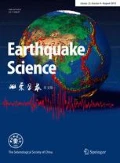Abstract
A large 3-dimension cellular automation model with 200 × 200 × 10 meshes has been designed. By using it 94304 "earthquakes" have occurred. The result shows that the range of scale invariance for small and large "earthquakes" are different; in the near time and in a closing space, large "earthquakes" often respond to each other.
Similar content being viewed by others
References
Bak P and Tang C, 1989. Earthquakes as a self-organized critical phenomenon. J Geophys Res, 94 (2): 15 635–15 637
Gao Y and Liu Z J, 1995. The dynamics meaning of stochastic CA. Earthquake Research in China, 11: 8–13 (in Chinese)
Lu Y Z and Lu Y J, 1994. The CA model with the faults and algorithmic complexity. Acta Seismological Sinica, 16: 183–189 (in Chinese)
Zheng J, 1993. Development on nonlinear scientific method and earthquakes mechanics test researches. in: Nonlinear Problem in Earthquake Science, Beijing: Seismological Press 137–169 (in Chinese)
Author information
Authors and Affiliations
About this article
Cite this article
Liu, CH., Chen, J. & Ling, XS. Using a large 3-D cell automation model to simulate energy-frequency, space and time distribution of earthquakes. Acta Seimol. Sin. 10, 375–378 (1997). https://doi.org/10.1007/s11589-997-0076-1
Received:
Revised:
Accepted:
Issue Date:
DOI: https://doi.org/10.1007/s11589-997-0076-1




